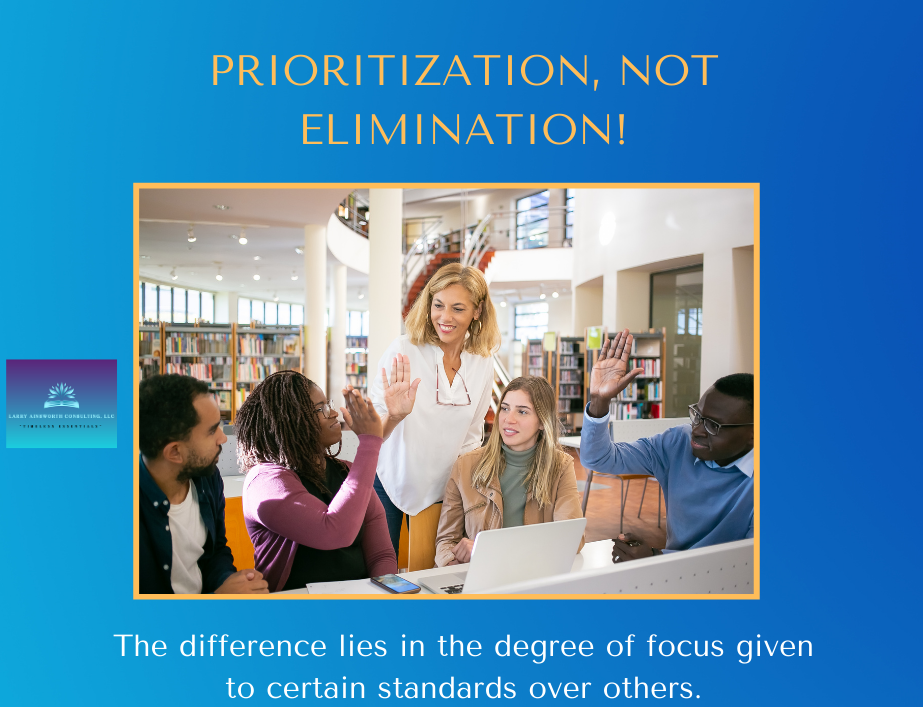Part 2 of this blog series strongly points out the importance of “prioritizing, not eliminating” any standards, describes how educators are using the long-established criteria for identifying Essential Standards, and previews the complete six-step process.
Prioritizing certain standards over others does not mean eliminating those standards that do not “make the cut” into the Essential Standards category. Prioritizing the standards has nothing whatsoever to do with “lowering the bar,” and everything to do with focus. It is about “less being more”. The difference lies in the degree of focus given to certain standards over others.
Identifying Essential Standards is not an irresponsible recommendation to ignore any standards not designated as priorities. It is imperative to continually remind everyone in the school and district community, “The Essential Standards are not all we teach,” even while allocating the greatest amount of instruction and assessment time to those standards determined to be essential for student success in current and succeeding grade levels. I always advise educators and school leaders to continually communicate to everyone this message: “Prioritization, not elimination!”
Certainly, all standards must be taught. The less rigorous supporting standards are a necessary first step in building students’ foundational understanding that will lead to their eventual attainment of the Essential Standards.
So, how do educators select these all-important Essential Standards and distinguish them from supporting standards?
OBJECTIVE SELECTION CRITERIA ARE A MUST!
Educators approach the prioritization process with questions: “Which standards do we choose as the priorities? How do we decide? What happens when we don’t agree?”
Without a definite set of selection criteria to prioritize standards, teachers who lack proven strategies for managing the volume of standards will often “pick and choose” those standards to emphasize based on what they like to teach, what they have instructional materials for, what they think students need to know and be able to do the following year, and/or standards they believe/know are most likely to appear on the state test. This leads to inconsistencies between and among educators as to which standards are emphasized, and which are not. Without using specific selection criteria for prioritization, everyone will probably choose (and emphasize) different standards from those of their colleagues.
Meeting together in grade-alike or course-alike teams, the prioritization process relies upon continual collaboration between and among teachers across the PK-12 spectrum. To prevent differing professional opinions from getting in the way of reaching a consensus as to which standards to choose as priorities, educators identify through in-depth discussion the standards that meet specific criteria. These established
REAL criteria objectify the selection process:
Readiness for the next level of learning (prerequisite concepts and skills students need to enter a new grade level or course of study). Educators especially think about the importance of this question: “Will proficiency of this standard provide our students with the essential knowledge and skills that are necessary for future success—in school, in life, and on state tests?”
Endurance (lasting beyond one grade or course; concepts and skills needed in life). Participating educators discuss this question: “Will proficiency of this standard provide students with the knowledge and skills that will be of value beyond the present?” For example, being proficient in reading informational texts and being able to write effectively for a variety of purposes across all grades and content areas are skills that will endure throughout a student’s academic career as well as later in life.
Assessments or External Exams (preparedness for standardized tests). Educators want to emphasize concepts and skills in the standards that students are most likely to encounter on annual state assessments, college entrance exams, and occupational competency exams.
Leverage (crossover application within the content area and to other content areas—interdisciplinary connections). For example, proficiency in creating and interpreting graphs, diagrams, and charts and then being able to make accurate inferences from them will help students in math, science, social studies, language arts, and many other areas. Similarly, the ability to write an analytical summary or a persuasive essay will help students in every academic discipline.
MORE COMPREHENSIVE OR RIGOROUS
Standards that meet all four of these established criteria qualify as Essential Standards. In addition, when considering whether to select one standard over another as being “essential”, I always recommend that teachers discuss and decide which one is the more comprehensive or rigorous—not the one that is more foundational. I then hear teachers saying to one another as they look closely at the standards, “If students could do this more challenging one, then they would certainly be able to do this other one.”
These preliminary selections are not “set in stone”, however. One of the great benefits of the prioritization process is how it relies upon professional discussions. The goal is for participating educators to reach an initial consensus regarding the Essential Standards they select, according to the four criteria. However, there will be opportunities to modify and change their preliminary selections along the way, particularly during the PK–12 alignment step (described fully in Part 3 of this series) when participants look to see how the selected priorities at one grade level align with the priorities selected at the grade levels below and at the grade levels above.
THE SIX-STEP ESSENTIAL STANDARD PROCESS
During Essential Standards workshops, educators follow a linear, step-by-step process to first select and then align Essential Standards from one grade to the next, PK-12. This alignment across the grades ensures a logical progression of those identified priorities from primary grades through high school grades and courses.
There are six Essential Standards process steps. Educators engage in the first two steps to select the Essential Standards. They then align the selected Essential Standards across the grades (Step 3) and confirm their selections by referring to state assessment information process (Step 4). All educators who were not involved in the initial selection process need to have a shared voice in finalizing the Essential Standards (Step 5) that are then published and distributed for use throughout the school district (Step 6).
Essential Standards Process Steps
Step 1: Make initial selections using the four selection criteria. Reach initial consensus.
Step 2: Bold selections for each grade or course on Google sheets or Excel spreadsheets.
Step 3: Align Essential Standards PK-12. Resolve uncertainties. Reach group consensus.
Step 4: Look for connections to external assessments (i.e., state tests).
Step 5: Acquire feedback from all school district educators.
Step 6: Revise, publish, distribute. Review annually to make changes or adjustments as needed.
ASSURED STUDENT COMPETENCIES
This sensible approach is far more likely to prepare students for successful attainment of the standards at each of the next grade levels. In this way, educators can strive to ensure that all students acquire the Essential Standards as grade- and course-specific “assured student competencies”. In this aptly worded phrase, “assured” simply means, “guaranteed”, and “competencies” are synonymous with “proficiencies”.
Essential Standards represent the “end game” of what students need to know and be able to demonstrate by the end of each grade level and course. This is why end-of-unit assessments are designed to primarily reveal student understanding of the Essential Standards—so that students can provide credible (reliable, valid) assessment evidence that they have indeed demonstrated competency in those standards that their teachers have determined to be the most critical for all students to learn.
COMING SOON: ESSENTIAL STANDARDS, PART 3
After the Essential Standards are selected in each grade for the first strand/domain/section of the content area in focus, the third step of the process is for the four grade-band teams (PK-2, 3-5, 6-8. 9-12) to come together and take a collective look across the PK-12 spectrum to see how to align the selected priorities from one grade to the next. This creates the “vertical flow” of those standards identified as being the most essential for all students to know and be able to do.
For more in-depth information on Essential Standards, here’s the link to Volume One of my Integrated Teaching and Learning series: https://www.larryainsworth.com/#VolumeOne and to the Essential Standards workshops at www.larryainsworth.com/workshops.
For continuing information about all the “timeless essentials” for creating integrated units of study, I hope you will follow me on Facebook, Linked In, and/or Instagram!
I am always happy to answer questions you may have about Essential Standards and any of the other “timeless essentials” presented in the three-volume series. Please feel free to contact me at larry@larryainsworth.com .

